
Vehicular and Pedestrian Traffic Safety: Signage and Awareness
Introduction
Traffic safety is a paramount concern in both vehicular and pedestrian environments, with signage and awareness playing pivotal roles in preventing accidents and ensuring the well-being of road users. This article explores the significance of effective signage and awareness campaigns in enhancing vehicular and pedestrian traffic safety.
Understanding Traffic Safety Challenges
- Intersection Risks
- High-Risk Zones: Intersections are common locations for vehicular and pedestrian accidents.
- Right-of-Way Confusion: Ambiguity regarding right-of-way rules can lead to collisions.
- Distracted Driving and Walking
- Technological Distractions: The use of smartphones and other devices contributes to distracted driving.
- Pedestrian Distractions: Pedestrians may be distracted while using mobile devices, compromising their awareness.
- Visibility Concerns
- Low Light Conditions: Reduced visibility during dawn, dusk, or nighttime increases the risk of accidents.
- Obstructed Sightlines: Poorly placed signage or infrastructure can obstruct sightlines for both drivers and pedestrians.
The Role of Signage in Traffic Safety
- Clear Directional Signage
- Intersection Guidance: Provide clear signage indicating directions, lanes, and upcoming turns.
- Pedestrian Crosswalks: Clearly mark pedestrian crosswalks with visible signage.
- Traffic Control Signs
- Stop and Yield Signs: Strategically place stop and yield signs to regulate vehicular flow and prevent collisions.
- Traffic Signal Indicators: Ensure visibility and clarity of traffic signal indicators for drivers and pedestrians.
- Speed Limit Signs
- Consistent Speed Limit Marking: Display speed limit signs consistently to inform drivers of permissible speeds.
- School Zones and Residential Areas: Implement reduced speed limit signs in school zones and residential areas.
- Warning Signs
- Pedestrian Crossing Warnings: Use warning signs to alert drivers to pedestrian crossings.
- Intersection Caution Signs: Place caution signs at intersections prone to accidents.
Enhancing Pedestrian Awareness
- Crosswalk Visibility
- Marked Crosswalks: Clearly mark crosswalks with high-visibility paint for pedestrian safety.
- Pedestrian Signage: Install signage indicating crosswalks and pedestrian right-of-way.
- Pedestrian-Focused Signage
- Look Both Ways Signs: Use signage to remind pedestrians to look both ways before crossing.
- Traffic Signal Education: Provide signs explaining the meaning of traffic signals for pedestrians.
- Public Awareness Campaigns
- Educational Signage: Implement signs conveying safe practices for both drivers and pedestrians.
- Community Engagement: Involve local communities in awareness campaigns through events and educational initiatives.
- Use of Technology
- Smart Crosswalks: Integrate technology into crosswalks, such as illuminated signs or signal-controlled lights.
- Pedestrian Mobile Alerts: Explore the use of mobile alerts to notify pedestrians of potential traffic dangers.
Collaborative Traffic Safety Measures
- Community Partnerships
- Local Authorities: Collaborate with local authorities for infrastructure improvements and traffic management.
- School Involvement: Involve schools in educating students about traffic safety through programs and events.
- Regular Signage Maintenance
- Visibility Checks: Conduct regular checks to ensure visibility of signage, especially during adverse weather conditions.
- Timely Repairs: Address any damaged or missing signage promptly to maintain effectiveness.
- Feedback Mechanisms
- Community Feedback: Establish mechanisms for community members to provide feedback on traffic safety concerns.
- Data Analysis: Analyze traffic data and accident reports to identify areas for improvement.
Conclusion
Vehicular and pedestrian traffic safety rely heavily on effective signage and awareness initiatives. Clear directional signage, traffic control signs, and pedestrian-focused measures contribute to safer road environments. Moreover, collaborative efforts between communities, local authorities, and technology integration play key roles in ensuring continuous improvement in traffic safety. By prioritizing visibility, education, and community engagement, we can create roadways that are not only efficient but, more importantly, safe for everyone.
Occupational Health Surveillance: Monitoring and Preventing Work-Related Health Issues
Energy Sector Safety Engineering: Challenges and Solutions in Oil, Gas, and Renewable Energy
Safety Data Analytics: Leveraging Big Data for Proactive Risk Management
Process Hazard Analysis (PHA): Methodologies and Applications for Safety Engineers
Transportation Safety Engineering: Ensuring Safe Operations in the Transportation Sector
Frequently Asked Questions (FAQs)
- Why is signage important for vehicular and pedestrian traffic safety?
- Signage is crucial for providing clear directions, regulating traffic flow, and alerting both drivers and pedestrians to potential hazards, contributing to overall safety on the road.
- What are common challenges in vehicular and pedestrian traffic safety?
- Challenges include intersection risks, distracted driving and walking, and visibility concerns during low light conditions or obstructed sightlines.
- How can signage enhance vehicular traffic safety?
- Clear directional signage, traffic control signs, speed limit signs, and warning signs contribute to vehicular traffic safety by providing guidance, regulating speed, and alerting drivers to potential hazards.
- How can pedestrian awareness be enhanced?
- Crosswalk visibility, pedestrian-focused signage, public awareness campaigns, and the use of technology (such as smart crosswalks) can enhance pedestrian awareness and safety.
- Why is community collaboration important for traffic safety measures?
- Community collaboration, involving local authorities, schools, and technology integration, allows for a comprehensive approach to traffic safety. It helps address specific local concerns, involve community members, and implement effective solutions for safer road environments.
























